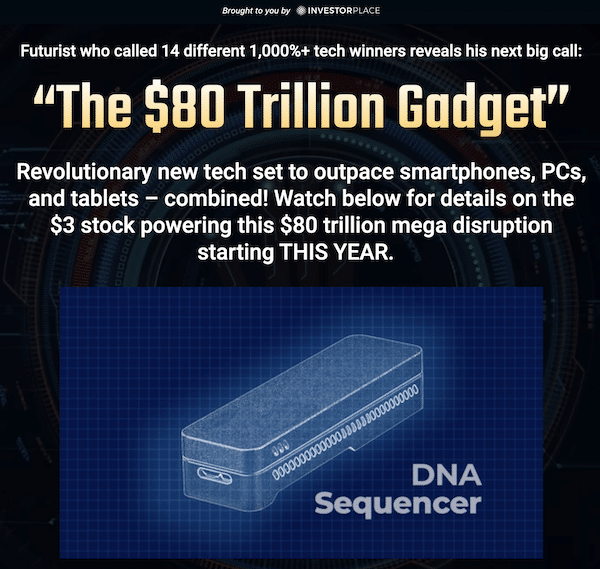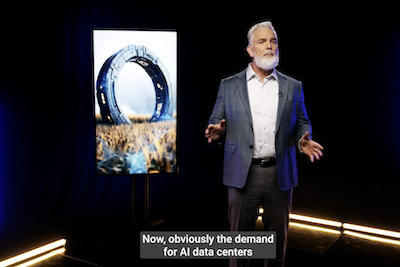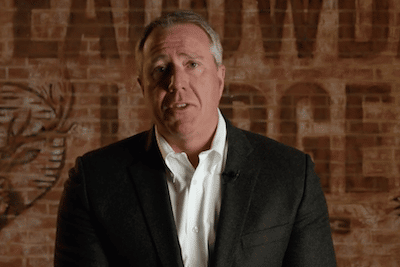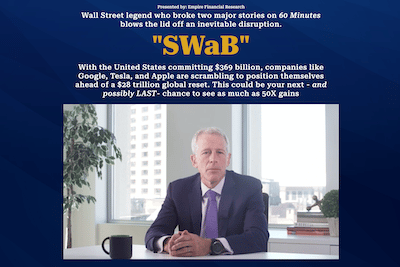Luke Lango just released an InvestorPlace presentation about “G.C.T. technology,” which he claims is part of an “$80 trillion DNA revolution.”
And during the presentation, Lango said there’s one “little-known company” sitting “dead center of this new tech revolution” that some suggest “could be the next Microsoft.”
What is GCT technology? And what stock is Lango teasing?
The technology Lango’s referring to is DNA sequencing and synthetic biology. And he shares the name of the company he’s bullish on (and why) in a report called “The Next Microsoft: The Software Company Powering the $80 Trillion DNA Revolution.”
However, I looked into his clues to figure out what stock he was teasing. And in this post, I’ll show you what I discovered about his “#1 GCT company” (including the ticker symbol).
I also managed to uncover a second stock he talked about in the presentation.
So I’ll share that with you too.
But first, let’s dig into Luke Lango’s G.C.T. technology (AKA DNA sequencing) prediction.
What Is G.C.T. Technology? (Breaking Down Luke Lango’s DNA Sequencing Prediction)
Luke Lango kicked off his latest InvestorPlace presentation, dubbed “The $80 Trillion Gadget,” by asking viewers to look at the following “gadget.”

According to Luke Lango, the technology inside it, which he refers to as “G.C.T.,” is set to “reinvent trillion-dollar industries across the world.”
So, what is G.C.T.?
G.C.T. stands for “Genetic Coding Technologies,” which appears to be a term Luke Lango came up with to describe DNA sequencing. And the gadget he showed in the presentation is a DNA sequencer (AKA machine that sequences an organism’s DNA).
“But you must be wondering… What is G.C.T. technology?
It all starts with this gadget I showed you earlier.
Believe it or not, this little thing can read your DNA and store, display, and analyze it on a computer.
It’s called a DNA Sequencer.
And it’s one of the most innovative applications of G.C.T. – or ‘Genetic Coding Technologies.'”
What is DNA sequencing? Genome.gov defines DNA sequencing as a lab technique that involves determining the exact sequence of bases (A, C, G, and T) in a DNA molecule.
And instead of using computer code (1s and 0s), a DNA sequencing machine analyzes DNA code, which is made up of As, Cs, Gs, and Ts.
DNA sequencing isn’t exactly new; it began in the late 1970s. But the machines used to sequence DNA have gotten better, cheaper, and faster over time. And the potential use cases for this technology go way beyond sectors like healthcare.
For example, DNA sequencing is a technology used in a multidisciplinary area of research called synthetic biology, which involves creating or redesigning “stuff” based on nature.
And this technology could potentially disrupt many different industries in the years ahead, such as healthcare, agriculture, manufacturing, and energy.
So, while Lango’s presentation may come across as a bit hyperbolic or “salesly” (at least, that was my impression), the trend he’s following is significant.
That said, he is the fifth well-known “investment guru” I’ve seen pitching the DNA sequencing / synthetic biology space within the past several months.
So this has become somewhat of a “hot trend” among stock pickers lately.
In any case, Lango specifically focused on how GCT technology could impact three main sectors in the presentation: healthcare, food, and manufacturing.
- The first main “GCT impact” he noted was “The End of Genetic Diseases.” Lango explained that millions of people have been diagnosed with diseases caused by DNA, and suggested that DNA sequencing is “now making it possible to create treatments.”
- The second impact he says G.C.T. could have relates to food. Lango said that millions of Americans get sick from food-borne illnesses each year and that DNA sequencing is transforming how we “prevent the spread of disease in the food supply chain.”
- Third, Lango talked about the impact G.C.T. could have on manufacturing and used Nylon plastic as an example, which is made from petrochemicals and crude oil and is found in virtually everything. But with DNA synthesis and synthetic biology, Lango said these plastics can now be engineered without crude oil.
There are many other potential uses cases within different sectors when it comes to DNA sequencing and synthetic biology, but these were the examples Lango shared. And while I always recommend doing your own research, what he said seems to hold up.
Nevertheless, aside from the technology itself, another key part of Luke Lango’s prediction has to do with where we are in this technology’s development and adoption cycle.
In short, Lango says that “every breakthrough technology you can think of” has two distinct phases – the “Gradual Phase” and the “Sudden Phase.”
What he described in the video is essentially the S-curve of innovation, whereby the tech starts out expensive, and adoption is limited while the tech is being developed. But during the second phase, if costs come down and the technology goes mainstream, the adoption rate can accelerate significantly.
And according to Luke Lango, “DNA sequencing is hitting the Sudden Phase right now” due to a significant reduction in the cost to sequence DNA.
“Sequencing your DNA used to cost more than the president’s Air Force One airplane…
But it could soon cost no more than spare change.
Simply put, this price drop is unprecedented.
And just like we’ve seen with new technologies in the past…
When they are cheap enough for the masses to adopt, they move into the Sudden Phase.”
What’s more, he believes there’s one company that’s the “crown jewel” of this “tech revolution” and compares it to Microsoft when internet adoption accelerated in the ’90s.
“And there is one company I believe is the crown jewel of this tech revolution.
It’s doing for G.C.T. what Microsoft did when the internet hit the Sudden Phase in the ’90s…”
Lango even goes as far as to suggest it could be the “next Microsoft.”
“Because one little-known company sits at the dead center of this new tech revolution.
Experts are saying this company could be the next Microsoft.
And the analysts at my firm could not agree more.”
What company is he talking about?
Read on.
Luke Lango’s “#1 GCT Company” (Stock Revealed)
As I mentioned at the outset, the only way to access the details about Luke Lango’s “#1 GCT Company” is to join his Innovation Investor service.
But I looked into his clues and believe I know what stock he’s teasing.
Here’s a look at the main clues Luke Lango shares about the company:
“And my research has led me to what could be the software giant of the DNA era.
The company is headed by an MIT scientist who helped build ARPANET, the technology that laid the foundation for the internet.
In 2009, after witnessing the huge potential in DNA and the falling costs of sequencing, he started this incredible company.
It specializes in programming the DNA of microorganisms…
And then licensing out those programs to companies who use them to make physical materials, consumer products, and more.
That’s why experts are saying this company could be the next Microsoft.
And the most exciting part: Bill Gates has already publicly backed and invested his own money in this company.”
So, based on that, we know Lango is tracking a DNA sequencing company that specializes in programming DNA and licensing those “programs” to other companies.
We also know that the company was started in 2009, that it’s headed by an MIT scientist who helped build ARPANET, and that Bill Gates has invested in it.
What other clues did he share?
Well, according to Luke Lango, the company has “major partnerships” with Quest Diagnostics, Cronos Group, and Bayer.
What could it be?
I believe Lango’s “G.C.T.” stock pick is Ginkgo Bioworks (ticker: DNA).
This was actually a pretty easy one to uncover because Lango’s presentation reminded me of a recent Whitney Tilson pitch I wrote about dubbed “America’s Next Big Monopoly” in which he too was teasing Ginkgo Bioworks.
So the first thing I did after going through Lango’s presentation was check to see if Ginkgo Bioworks was a match because that was my hunch, and sure enough, it was.
Here’s an overview of how it matches Lango’s clues:
- Ginkgo Bioworks is a Boston-based biotech company that was founded in 2009. DNA sequencing is a foundational part of what the company does, but according to the company website, it’s building a platform to enable its customers to program cells as easily as programming a computer. And it is working on automating and scaling the process of organism engineering. So, it appears to match Lango’s description.
- The company was co-founded by multiple MIT scientists. One of those is CEO Jason Kelly, and the other is Tom Knight, who played an important role in developing ARPANET in the 1960s and 1970s.
- Bill Gates invested $275 million into Ginkgo Bioworks.
- And finally, the company has partnerships with all three companies Lango mentioned.
So, Ginkgo Bioworks is Lango’s “#1 GCT company.”
He also mentioned a second company in the presentation, and after checking into his clues, I think I may know what that one is too.
This second company relates to the “gadget” (DNA sequencing machine) Luke Lango shared at the beginning of the presentation (which I shared a screenshot of earlier).
Here are his clues:
“You remember this DNA sequencer I showed you earlier?
There is a good reason why I chose THIS one for today’s presentation.
Because this piece of tech is on the bleeding edge of the newest sequencing breakthrough.
It’s called a ‘Third Generation Sequencer.'”
[…]
“This company has patented its technology so NONE of their competitors can steal it!”
[…]
“It has already been used to sequence DNA on the International Space Station.”
That’s not a lot to go off, but after checking out which DNA sequencers have been used on the International Space Station, I came across this article that shows that the MinION sequencing machine was used to sequence DNA in space.
And I believe this is the “gadget” Luke Lango teases in the presentation.
Why? Well, the MinION sequencing machine has been used on the International Space Station, it looks like the device Lango shared in the presentation, and the article classed it as a third-generation sequencer. In other words, it matches what Lango said.
But I still wanted confirmation. So I went over to the website of the company that makes the MinION, Oxford Nanopore Technologies, and the device shown on the MinION product page is a near-perfect match in appearance to what Luke Lango shared in the presentation.
So this has to be the sequencer he’s referring to.
As for the stock, Oxford Nanopore Technologies Limited is a UK-based company, but it is listed on the OTC (over-the-counter) market under the ticker ONTTF.
So, there you have it, two picks for the price of none (lol).
Of course, those are just my guesses; and I’m not guaranteeing I’m right. And I’m certainly not suggesting anyone make any investment decisions based on what I’ve shared. I have no idea if either of the stocks I’ve mentioned will make good investments.
But I do think this is what Lango is teasing. And if you want to find out for sure, the best thing to do would be to check out his service, Innovation Investor. Because as a subscriber, you get access to the research reports he’s put together on both of his picks.
In the next section, I’ll give you an overview of what the service is about, what you get if you join, and my opinion about whether or not it’s a legit and worthwhile service.
Recommended: Go here to see my #1 rated stock advisory of 2024
Overview of Innovation Investor
Innovation Investor is a stock advisory service run by Luke Lango of InvestorPlace focused on what he describes as “transformative technology investment opportunities.”
Each month, he releases a new issue of Innovation Investor, which details his latest research and recommended stock pick. And as a subscriber, you can decide which investment ideas you want to follow and which ones you want to pass up.
Aside from the newsletters, you get access to a model portfolio that shows you Lango’s latest active stock picks, a daily breakdown where Lango shares his insights into the market and provides updates on the portfolio, and the following research reports.
- The Next Microsoft: The Software Company Powering the $80 Trillion DNA Revolution.
- The Next DNA Sequencing Giant
- 3 World-Changing AI Stocks to Buy NOW
The first two reports detail the companies he teased in the presentation (the ones I just shared my guesses on), and the third one details three AI-related stocks. Lango didn’t share many clues on those stocks, though, so I’m not sure what they are.
Nevertheless, that is the gist of what you get as a subscriber of Innovation Investor. It’s essentially a tech-focused investment research service where Lango shares his top picks in industries like electric vehicles, artificial intelligence, and DNA sequencing, among others.
The cost to join is usually $199 if you join through the default InvestorPlace sign-up page, but Lango’s running a special as part of his “GCT” pitch that allows you to join for $79. Although there are higher-priced options ($99 or $129) that give you additional research reports.
If you want to know more about the service, check out my Innovation Investor review. In it, I go into more detail on how the service works and what’s included.
Or if you couldn’t be bothered reading that… the bottom line is that the service is legit and potentially worthwhile if you’re interested in tech and biotech stocks. There’s no guarantee you’ll see a profit, no service can promise that, but it’s a genuine service.
Who Is Luke Lango?
Luke Lango is an investment guru that works with a financial publishing company called InvestorPlace, which describes him as a “growth-focused equities investor and analyst.”
Aside from Innovation Investor, Lango runs numerous services for InvestorPlace, including Daily 10X Stock Report, Early Stage Investor, and the Crypto Investor Network. And from what I’ve seen, most of his picks are either tech or biotech-related.
Before joining InvestorPlace, Lango was the founder of an investment fund (L&F Capital Management, LLC) and worked at a startup called Scoutables.
Does he have a good track record?
I don’t know what Lango’s entire track record is like, but he does appear to be one of the more successful stock pickers out there.
For instance, he was ranked as the top financial blogger in 2020 on TipRanks, an independent site that rates different recommendations stock pickers make.
And according to the presentation, Lango has “called 14 different stocks that have soared from 1,000% to as high as 12,000% in value” over the past few years. And he shared numerous examples of his winning picks in the presentation.
There are two important caveats to this, though.
First of all, just because someone has picked great stocks in the past doesn’t mean they will in the future. So you shouldn’t expect that his ideas will make you money. And second, Lango has no doubt had his share of losing picks as well.
Either way, based on everything I’ve seen, he is the real deal. And if you want to see what other stocks he’s recommended, I’ve written about several of his presentations.
For example, most recently, I wrote about a LiDAR company he teased. And before that, I uncovered his “forever battery” stock pick.
So you might find those worth checking out because in each of the above posts I break down his pick in a similar way that I’ve done here.
Bottom Line
Luke Lango’s “G.C.T.” presentation centers around DNA sequencing and the potential benefits of this tech in sectors like healthcare, manufacturing, and agriculture.
And during the presentation, he hinted at two companies he’s interested in.
My research suggests that the first company is Ginkgo Bioworks, and the second one is Oxford Nanopore Technologies Limited.
But as mentioned, the only way to know for sure would be to subscribe to Innovation Investor, a tech and biotech-focused advisory he runs for InvestorPlace.
Whether or not you join is up to you; I’m not affiliated with this company, so it makes no difference to me. But hopefully, you find what I’ve shared helpful either way. And if you’d like to share your thoughts on any of this, feel free to chime in below. Thanks for reading.












Please note: By submitting a comment using the above comment form, you confirm that you agree with the storage and handling of your data by this site as detailed in our Privacy Policy.